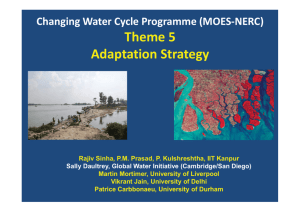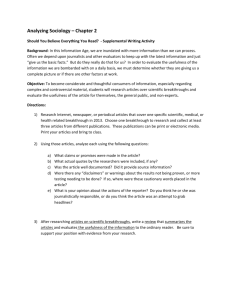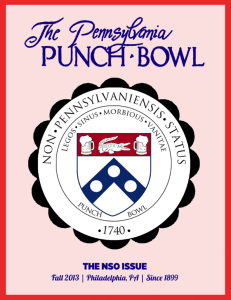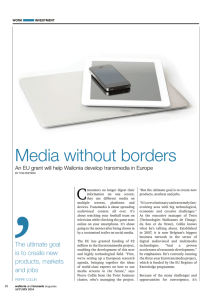types of market research and its usefulness
advertisement
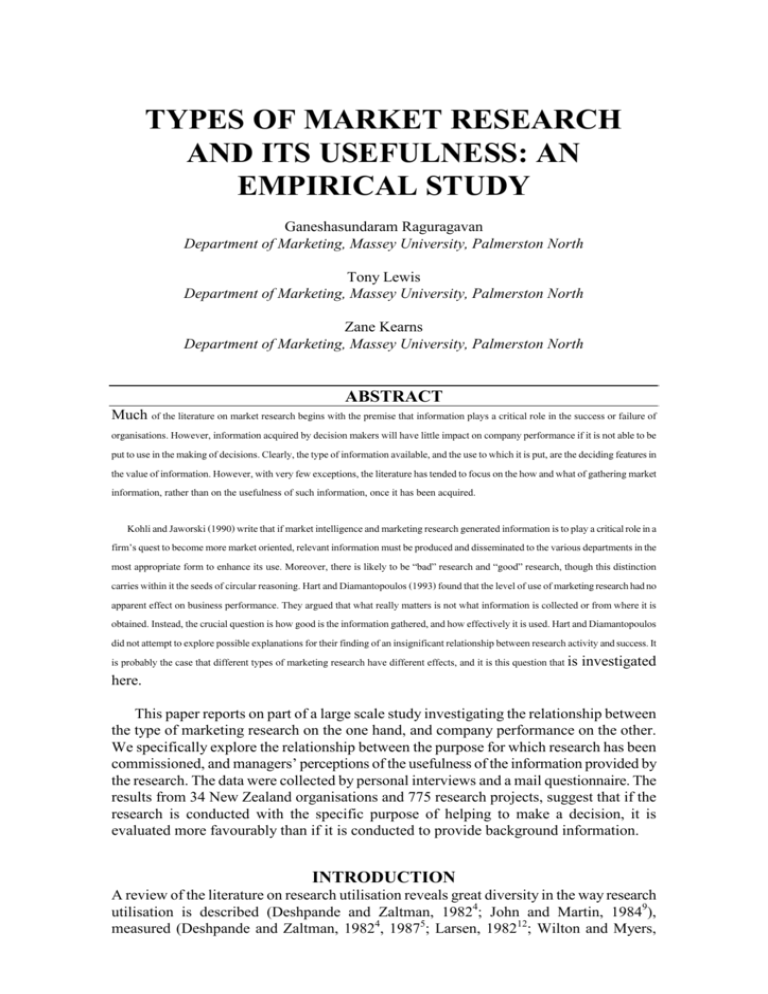
TYPES OF MARKET RESEARCH AND ITS USEFULNESS: AN EMPIRICAL STUDY Ganeshasundaram Raguragavan Department of Marketing, Massey University, Palmerston North Tony Lewis Department of Marketing, Massey University, Palmerston North Zane Kearns Department of Marketing, Massey University, Palmerston North ABSTRACT Much RIWKHOLWHUDWXUHRQPDUNHWUHVHDUFKEHJLQVZLWKWKHSUHPLVHWKDWLQIRUPDWLRQSOD\VDFULWLFDOUROHLQWKHVXFFHVVRUIDLOXUHRI RUJDQLVDWLRQV+RZHYHULQIRUPDWLRQDFTXLUHGE\GHFLVLRQPDNHUVZLOOKDYHOLWWOHLPSDFWRQFRPSDQ\SHUIRUPDQFHLILWLVQRWDEOHWREH SXWWRXVHLQWKHPDNLQJRIGHFLVLRQV&OHDUO\WKHW\SHRILQIRUPDWLRQDYDLODEOHDQGWKHXVHWRZKLFKLWLVSXWDUHWKHGHFLGLQJIHDWXUHVLQ WKHYDOXHRILQIRUPDWLRQ+RZHYHUZLWKYHU\IHZH[FHSWLRQVWKHOLWHUDWXUHKDVWHQGHGWRIRFXVRQWKHKRZDQGZKDWRIJDWKHULQJPDUNHW LQIRUPDWLRQUDWKHUWKDQRQWKHXVHIXOQHVVRIVXFKLQIRUPDWLRQRQFHLWKDVEHHQDFTXLUHG .RKOLDQG-DZRUVNLZULWHWKDWLIPDUNHWLQWHOOLJHQFHDQGPDUNHWLQJUHVHDUFKJHQHUDWHGLQIRUPDWLRQLVWRSOD\DFULWLFDOUROHLQD ILUPuVTXHVWWREHFRPHPRUHPDUNHWRULHQWHGUHOHYDQWLQIRUPDWLRQPXVWEHSURGXFHGDQGGLVVHPLQDWHGWRWKHYDULRXVGHSDUWPHQWVLQWKH PRVWDSSURSULDWHIRUPWRHQKDQFHLWVXVH0RUHRYHUWKHUHLVOLNHO\WREHvEDGwUHVHDUFKDQGvJRRGwUHVHDUFKWKRXJKWKLVGLVWLQFWLRQ FDUULHVZLWKLQLWWKHVHHGVRIFLUFXODUUHDVRQLQJ+DUWDQG'LDPDQWRSRXORVIRXQGWKDWWKHOHYHORIXVHRIPDUNHWLQJUHVHDUFKKDGQR DSSDUHQWHIIHFWRQEXVLQHVVSHUIRUPDQFH7KH\DUJXHGWKDWZKDWUHDOO\PDWWHUVLVQRWZKDWLQIRUPDWLRQLVFROOHFWHGRUIURPZKHUHLWLV REWDLQHG,QVWHDGWKHFUXFLDOTXHVWLRQLVKRZJRRGLVWKHLQIRUPDWLRQJDWKHUHGDQGKRZHIIHFWLYHO\LWLVXVHG+DUWDQG'LDPDQWRSRXORV GLGQRWDWWHPSWWRH[SORUHSRVVLEOHH[SODQDWLRQVIRUWKHLUILQGLQJRIDQLQVLJQLILFDQWUHODWLRQVKLSEHWZHHQUHVHDUFKDFWLYLW\DQGVXFFHVV,W LVSUREDEO\WKHFDVHWKDWGLIIHUHQWW\SHVRIPDUNHWLQJUHVHDUFKKDYHGLIIHUHQWHIIHFWVDQGLWLVWKLVTXHVWLRQWKDW is investigated here. This paper reports on part of a large scale study investigating the relationship between the type of marketing research on the one hand, and company performance on the other. We specifically explore the relationship between the purpose for which research has been commissioned, and managers’ perceptions of the usefulness of the information provided by the research. The data were collected by personal interviews and a mail questionnaire. The results from 34 New Zealand organisations and 775 research projects, suggest that if the research is conducted with the specific purpose of helping to make a decision, it is evaluated more favourably than if it is conducted to provide background information. INTRODUCTION A review of the literature on research utilisation reveals great diversity in the way research utilisation is described (Deshpande and Zaltman, 19824; John and Martin, 19849), measured (Deshpande and Zaltman, 19824, 19875; Larsen, 198212; Wilton and Myers, 198617), and categorised (Deshpande and Zaltman, 19824, 19875; Lee, Acito, and Day, 198713; Wilton and Myers, 198617). For instance, research utilisation has been referred to as: (1) the extent to which research is used directly to guide behaviour and make decisions and; (2) the extent to which information leads to the reduction of uncertainty for decision makers, and (3) the extent to which there have been specific changes in behavioural, cognitive, and affective areas. The various measures of research utilisation proposed to date also differ in their focus, scope, and process. Kohli and Jaworski10 (1990) write that if market intelligence and marketing research generated information is to play a critical role in a firm’s success, the way in which it is produced and disseminated to the various departments is crucial. However, little empirical work has been conducted on the link between the type and extent of marketing research activities and business performance. Many studies focus primarily on the extent to which the marketing research has been adopted by organisations, rather than its specific consequences. The literature shows only one empirical study of the consequences of marketing research. This noteworthy exception is the study of Hart and Diamantopoulos7 (1993). Hart and Diamantopoulos found a surprising non-significant relationship between research activity and success. They did not, however, attempt to explore possible explanations for this finding. One possible explanation is that different types of marketing research have different effects, some positive and some negative, with the result of an aggregate null relationship. TYPE OF RESEARCH USE The literature on research use talks of the existence of two key dimensions in the evaluation of research: namely, instrumental and conceptual (Deshpande and Zaltman, 19824). Instrumental use, or what in our paper is termed ‘decision research’ has been defined as the direct application of research findings and conclusions to solve a specific problem, or to make a particular decision (Deshpande and Zaltman, 19824). In this type, a problem exists and the solution depends on the research providing information to fill the information gaps. Conceptual use, or ‘background research’ in our paper, refers to the indirect application of information, in the sense that information is used to broaden the managerial knowledge base without serving any one particular project (Moorman, 199515). Background research is commissioned to understand what is prevailing in the market and to get a feel for customer satisfaction. It is also used to understand the after-effects of decisions made on the basis of decision research. Menon and Varadarajan14 (1992) say that such research is less direct than action-oriented research. METHODOLOGY A list of company names was compiled from the New Zealand Market Research Society’s Directory (1998) with assistance from the New Zealand Business Who’s Who (39th edition). Market research companies were excluded and agreement to participate was sought from 87 client companies who thus made up the initial sample. The sample covered a wide spectrum of service and manufacturing companies. Initially, the chief executives of the 87 organisations were approached with an outline of the intended research. The executives were invited to nominate a participant from among their staff, who could be asked to provide all information relating to market research that had been commissioned or conducted over the past 10 years. Of the initial 87 contacts, 34 organisations agreed to participate in the research. After a relationship was established with people nominated by the chief executive, 34 in-depth interviews were undertaken over a six-month period between June and November 1999. These interviews obtained detailed information on the research projects including purposes, expectations, selection criteria, methodology, type, results, implementation of outcomes, and the influence of organisational factors. Follow-up interviews were held with some respondents to confirm and clarify responses, as well as to gather other qualitative data on the operational aspects of research. Based on the information obtained in this first round of interviewing, the research projects (n=3018) were classified as ‘decision type’ or ‘background type’. This was accomplished by the lead researcher reviewing each project’s objectives and methodology. Not all the projects conducted by the organisations were selected for the analysis described in this paper. The number of projects from each organisation was limited to a maximum of 45 decision type projects and an equal number of background projects. If there was more than 45, then 45 were randomly selected from each organisation. In the absence of any decision research project a random sample of a maximum of 14 projects was selected. In total, 775 projects were selected from the 34 participating organisations. This was an overall sampling ratio of 25% of the total number of projects. Out of the 775 projects selected for evaluation, 342 (44%) were decision research and 433 (56%) were background research. To obtain the data required for the study each of the projects was rated by respondents on five-point scale (strongly agree (5) to strongly disagree (1)) on the dimensions given in Exhibit 1. Exhibit 1 2YHUDOOWKHSURMHFWZDVYHU\XVHIXO The project gave us a good understanding of our market After the research it was quite clear what action should be taken The project was well worth the money spent INVOLVEMENT BIAS The influence of involvement in the research project by the manager has been emphasised by various writers (Curren, Folkes and Steckel, 19853; Bradley, 19782; Deshpande and Zaltman, 19875; Lee, Acito, and Day, 198713). For example, it is speculated that projects in which the respondent was involved in might be highly regarded, whilst ones commissioned by others might be viewed less favourably. To investigate the potential for bias in the responses due to personal involvement in the commissioning of the research, respondents were asked to rate ‘I personally was involved in the project’ on the same five-point scale. Table 1 reports the ratings of the projects by the respondents’ level of involvement, and shows that there was only slightly more involvement in ‘decision research’ projects than in ‘background research’ projects. Furthermore, the mean scores on the involvement scale show no statistical difference, with the mean involvement for Decision research being 2.6, and for Background research being 2.4. Thus if the ratings are biased, they are probably biased by the same amount in each category, and the bias can safely be ignored when comparing the results between the different types of research. Table 1 - Distribution of Responses for Involvement by Research Type Measurement Variable Type^ Respondents Ratings of Projects (rounded %ages) Strongly Agree Agree Neutral Disagree Strongly Disagree Involvement DR 15 23 10 BR 13 20 12 ^ Type of Research (DR-Decision Research; BR-Background Research) 12 40 8 47 UNIVARIATE RESULTS Tables 2 and 3 show the results of the analysis of the different types of marketing research and the ratings on usefulness, market understanding, actionable, and value. Table 2 shows the distribution of the responses to the rating questions. CHI-SQUARE statistics are also reported to test if the cell counts differed from that expected if there was no relationship between the rating and the type of research. While the chi-square test is limited for this sort of data, the results show that the responses were unequal for each classification. Table 2 - Distribution of Responses by Research Type Measurement Type^ Variables Respondents Ratings of Projects (row %ages rounded) Strongly Agree Agree Neutral Disagree Strongly Disagree Overall DR 31 62 7 1 usefulness BR 9 40 44 7 Provided market DR 6 44 35 14 .6 understanding BR 25 51 19 5 .2 Indicated DR 37 54 9 clear action BR 8 26 45 DR 24 65 11 Value for ChiSquare * * * 20 .5 * BR 9 27 46 18 1.6 ^ Type of Research (DR-Decision Research; BR-Background Research) *Significant at 0.01 level or better. We are aware of the problems of applying Chi-Square to ordinal data. ANOVA results are reported in Table 3 to see whether any significant differences exist between the type of research in relation to means of each of the measurement variables. The results indicate that all of the differences in the means were statistically significant at the .01 level. Table 3 - Project Ratings by Type of Research Measurement Variables Classification of Projects (Mean Score) Overall Difference P n=775 Decision Research n=342 Background Research n=433 Eta Squared Overall usefulness 3.8 4.2 3.5 0.7 * .22 Provided good market understanding 3.7 3.4 4 0.6 * .10 Indicated clear action 3.7 4.3 3.2 1.1 * .32 Value for money 3.6 4.1 3.2 0.9 * .25 Involvement 2.5 2.6 2.4 0.2 * Significant at 0.01 or better. We are aware that caution should be used in interpreting anova results on ordinal data. Overall Usefulness The results presented in Tables 2 and 3 show that ‘decision research’ projects scored more highly than ‘background research’ projects on ‘Overall the project was very useful’. This supports Shrivastava’s16 (1987) argument of “usefulness of research is its ability to provide decision makers with a rationale for making decisions, thereby prompting actions in organisations”. Furthermore, Table 2 indicates that 93% of the ‘decision research’ projects and 49% of the ‘background research’ projects were rated as useful (agree/strongly agree). Provided Good Market Understanding Table 3 indicates that ‘background research’ scored higher on ‘The project gave us a good understanding of our market’. This is as expected; that is what it is carried out for. It is to provide general enlightenment and can be considered as developing the managerial knowledge base. Table 2 shows that 76% of the background research projects were rated as ‘provided good market understanding’ (agree/strongly agree) but only 51% of the ‘decision research’ projects were rated in this way. Indicated Clear Action This scale measured the direction provided by the research. Table 3 shows that ‘decision research’ projects in general scored more highly than ‘background research’ projects on ‘After the research it was quite clear what action should be taken’. The response ratings also indicate that 91% of the ‘decision research’ projects were rated as ‘provided clear direction for action’ (agree/strongly agree) compared to 34% of the ‘background research’ projects. Value for Money The value of a study to the manager is affected by the costs incurred in conducting the study compared to its worthiness in terms of applicability. The cost of a study is perceived in both monetary and non-monetary terms, such as time and energy expended in commissioning or conducting the study, or in collecting the information. Table 3 shows that ‘decision research’ projects (89%) scored more highly than ‘background research’ projects (36%) on ‘The project was well worth the money spent’. Examining the managers’ responses on project usefulness shows that none of the projects, whether ‘decision research’ or ‘background research’, was rated ‘strongly disagree’. This result corresponds with the studies that show that managers express a generally positive, favourable attitude toward marketing research, and consider it to be a valuable tool (Bellenger, 19791; Holbert, 19748; Krum, 197811; Deshpande and Zaltman, 19824; and Deshpande and Jeffries, 19816). MULTIVARIATE RESULTS The univariate results give some measure of difference in the value of research in favour of decision research. Each variable indicates in some way a common-sense dimension of the over-all value of research projects. However, it is possible that if the four variables were reduced to the underlying dimensions we would find a greater difference in the evaluation. With that in mind, a MANOVA was performed to show the combined effect of all four (excluding involvement) variables. The results are given in Table 4 indicate a much enhanced difference in the value of the different types of research. The difference is significant at .01 level and the Eta-squared value shows that 98 percent of the variation in the single measure of usefulness is explained by research type. Table 4 - Multvariate MANOVA Results Model (Combined) F Eta-squared 7529 .98 Significant at 0.01 level or better. Exploring the Dimensionality of Project Rating The above MANOVA results however impose a single dimension on the results. It could perhaps be instructive to explore a more appropriate number of dimensions. This approach is supported by Table 5 which gives the correlation coefficients between the original rating variables. This shows high correlations between ‘overall usefulness’ and ‘indicated clear action’, and ‘value for money’, but a low correlations with ‘provided good market understanding’. Table 5 - Relationship Between Measurement Variables Overall usefulness Overall usefulness 1.00 Provided good market understanding 0.17 Provided good market Indicated clear action understanding 1.00 Indicated clear action 0.79 0.04 1.00 Value for money 0.80 0.08 0.78 The unrotated two component principal components solution given in Table 6 shows a simple and meaningful grouping of variables. Table 6 - Unrotated Factor Matrix Component Overall usefulness Value for money Indicated clear action Provided good market understanding 1 2 .93 .93 .92 .17 .02 -.08 -.13 .98 As expected ‘provided good market understanding’ is the odd one out. With that in mind we reduced the four variables to two principal components and called them ‘valuable research’ for the first component, and ‘informational research’ for the second component. The three variables ‘value for money’, ‘indicated clear action’ and ‘overall usefulness’ loaded significantly in the first component and the variable ‘provided good market understanding’ loaded significantly on the second component. These two new components, accounted for 90 percent of the variation of the original variables. The ‘valuable research’, we would expect from the univariate analysis, will contain information relating to decision type research and the ‘informational research’ will provide information regarding background type research projects. Table 7 gives the results of ANOVA on the two factor solution. This table shows a slight improvement, in terms of the Eta-squared values, on the univariate anova using four variables. Table 7 - Project Ratings by Factor Measurement Variables Mean Factor Scores Difference P Decision Research n=342 Background Research n=433 Valuable research .65 -.51 1.14 * .32 Informational research *Significant at 0.01 or better. -.40 .31 0.91 * .12 Eta Squared Further analysis was conducted to investigate the extent and type of research commissioned by the respondents’ organisations and their ratings of usefulness. Table 8 shows that the ratings by the companies which are ‘high’ in decision oriented research scored more highly than “low” in decision oriented projects on “Valuable research”. On the other hand, companies which are “low” in decision oriented projects scored higher on “Informational research.” The differences in the means between ‘high’ and ‘low’ decision oriented companies were significant at the .01 level. This indicates companies which are ‘high’ in decision oriented research consider their research projects as valuable in terms of its usefulness, money value and providing direction for action. On the other hand, companies which are “low” in decision oriented projects consider their research as useful only in terms of providing market information. Table 8 - Project Ratings Type of Companies Ranked mostly on Decision research 0HDVXUHPHQW9DULDEOHV 9DOXDEOH5HVHDUFK Overall usefulness Indicated clear action Value for money ,QIRUPDWLRQ5HVHDUFK Provided good market understanding High Moderate Low n=10 0.19 4.1 4.0 3.8 -0.04 3.6 n=17 -0.12 3.7 3.7 3.6 0.01 3.7 n=7 -0.31 3.7 3.3 3.3 0.18 3.8 Difference^ P Overall n=34 0.5 0.4 0.7 0.5 0.2 0.2 * * * * * * 3.8 3.7 3.6 3.7 A'LIIHUHQFHEHWZHHQt+LJKwDQGv/RZwGHFLVLRQRULHQWHGFRPSDQLHV 6LJQLILFDQWDWOHYHORUEHWWHU:HDUHDZDUHRIWKHSUREOHPVRIDSSO\LQJ&KL6TXDUHWRRUGLQDOGDWD CONCLUSIONS We have classified research into that which seeks to understand what is prevailing in the market and to get a feel for customer satisfaction (background research), and that which seeks to evaluate alternative courses of action (decision research). ‘Decision research’ includes all or most of the factors proposed by Shirivastava16 (1987) as the important criteria for determining the usefulness of research. These criteria include information which is of personal interest and sense to the users; related to the tasks facing the users; action-oriented; and innovativeness. The reason for the above results may be because ‘decision research’ includes the underlying dimension (realism, accuracy, specificity to the addressed problem, consistency of research output and implications, comprehensiveness and completeness, and validity of research) proposed by John and Martin9 (1984) as important criteria for determining the value of research. On the other hand, it is difficult to measure the effect of ‘background research’, especially in the long-term, since this process is subtle and indirect and therefore managers may not be able to identify specific effects or observe the influence. This also supports the findings of Bellenger1 (1979), Holbert8 (1974), and Krum11 (1978) that marketing research results have less impact if they are not actionable or sufficiently convincing to be used in critical decisions. Our survey indicates that background research predominates over decision research as a research activity, yet is regarded as less useful by managers. Over the four dimensions (usefulness, market understanding, value for money, indicate clear action) background research was evaluated less favourably than decision research. This result was even more marked when the dimensionality of the ratings was studied. A possible explanation for the apparent contradiction between the comparatively lower rating of background research and the higher proportion of background research conducted is that the convention among research companies and marketers is to do background research, and they are able, because of their supposed expertise in such matters, to make their views prevail. Conversely, a possible explanation for the fact that managers favour decision research is that it enables managers to test their ideas and concepts, and to find an implementable solution. It also gives a clear direction for decision making and puts an emphasis on the financial implications of the decisions. If the findings of this study are substantiated by replication and analysis of many sets of data, then the conclusion is that managers should have a greater say in the type of research that is carried out for them, and that research companies should put greater emphasis on decision type research when pitching for business. In light of the heavy predominance of background research, this will require a major shift in the thinking of research companies and marketers. REFERENCES [1] Bellenger, D. (1979). The Marketing Manager’s View of Marketing Research. Business Horizons, 22 (June), 59-65. [2]Bradley, G. (1978). Self-serving Biases in the Attribution Process: A Reexamination of the Fact or Fiction Question. Journal of Personality and Social Psychology, 36 (1), 56-71. [3]Curren, M., Folkes, V. & Steckel, J. (1985). Explanation for Successful and Unsuccessful Marketing Decisions: The Decision Maker’s Perspective. Journal of Marketing, 56, 18-21. [4]Deshpande, R.& Zaltman, G. (1982). Factors Affecting the Use of Market Research Information: A Path Analysis. Journal of Marketing Research, 19, 14-31. [5]Deshpande, R. & Zaltman, G. (1987). A Comparison of Factors Affecting Use of Marketing Information in Consumer and Industrial Firms. Journal of Marketing Research, 24, 114118. [6]Deshpande, R. & Jeffries, S. (1981). Attitude Affecting the Use of Marketing Research in Decision Making: An Empirical Investigation. Educators’ Conference Proceedings, Kenneth L. Brenhardt et al., eds. Chicago: American Marketing Association, 1-4. [7]Hart, S. & Diamantopoulos A. (1993). Marketing Research Activity and Company Performance: Evidence from Manufacturing Industry. European Journal of Marketing, 27(5), 54-72. [8]Holbert, N.(1974). How Managers See Marketing Research. Journal of Advertising Research, 14 (December), 41-46. [9]John, G. & Martin, J. (1984). Effects of Organisational Structure of Marketing Planning on Credibility and Utilisation of Plan Output. Journal of Marketing Research, 21, 170-83. [10]Kohli, A. & Jaworski, B. (1990). Market Orientation: The Construct, Research Propositions and Managerial Implications. Journal of Marketing, 54, 1-18. [11]Krum, J. R. (1978). B for Marketing Research Departments. Journal of Marketing, 42 (October), 8-12. [12]Larsen, J. (1985). Effect of Time on Information Utilisation. Knowledge: Creation, Diffusion, Utilisation, 7(2), 143-159. [13]Lee, H., Acito, F.& Day, R. L. (1987). Evaluation and the Use of Marketing Research by Decision Makers: A Behavioural Simulation. Journal of Marketing Research, 24, 187-96. [14]Menon, A.& Varadarajan, R. (1992). A Model of Marketing Knowledge Use Within Firms. Journal of Marketing, 56, 53-71. [15]Moorman, C. (1995). Organisational Market Information Processes: Cultural Antecedents and New Product Outcomes. Journal of Marketing Research, 32, 318-355. [16]Shrivastava, P. (1987). Rigor and Practical Usefulness of Research in Strategic Management. Strategic Management Journal, 8, 77-92. [17]Wilton, P. & Myers, J. (1986). Task, Expectancy, and Information Assessment Effects in Information Utilisation Processes. Journal of Consumer Research, 12, 469-86.

